How to create a newspaper with free Canva templates: a step-by-step guide
If you’re looking to create a newspaper using Canva, you’re in the right place. At Newspaper Club, we make it simple to design and print...
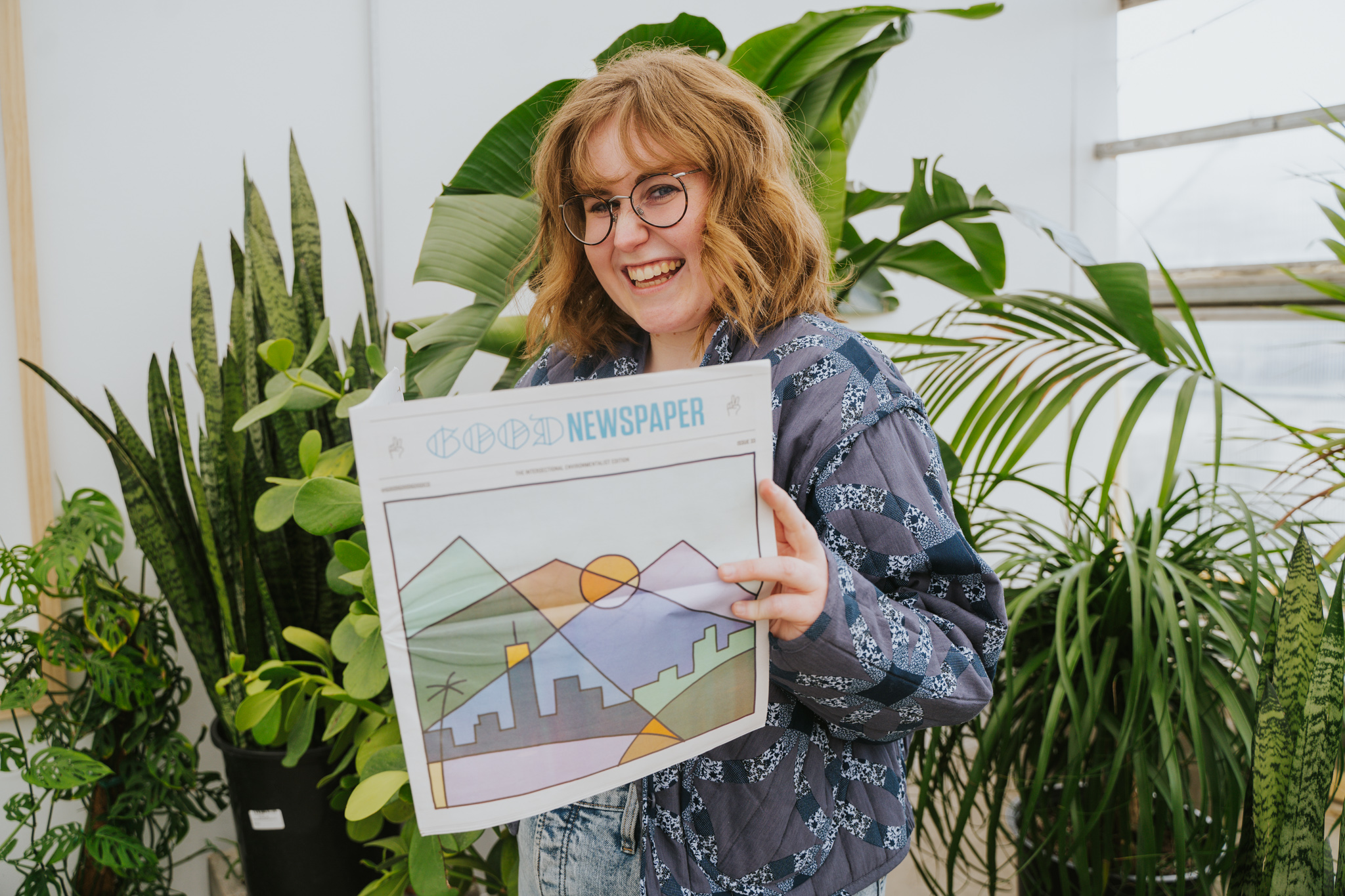
Good news can feel hard to come by these days. That’s why storyteller and photographer Branden Harvey decided to create the Goodnewspaper, a monthly print newspaper sharing hopeful headlines from around the world.
The idea came to Branden in 2017, but he was initially intimidated by the costs of publishing. “I had a few friends who started magazines and it seemed expensive,” he says. “Expensive to print, expensive to ship. And my goal was to make sure that this good news was super accessible.”
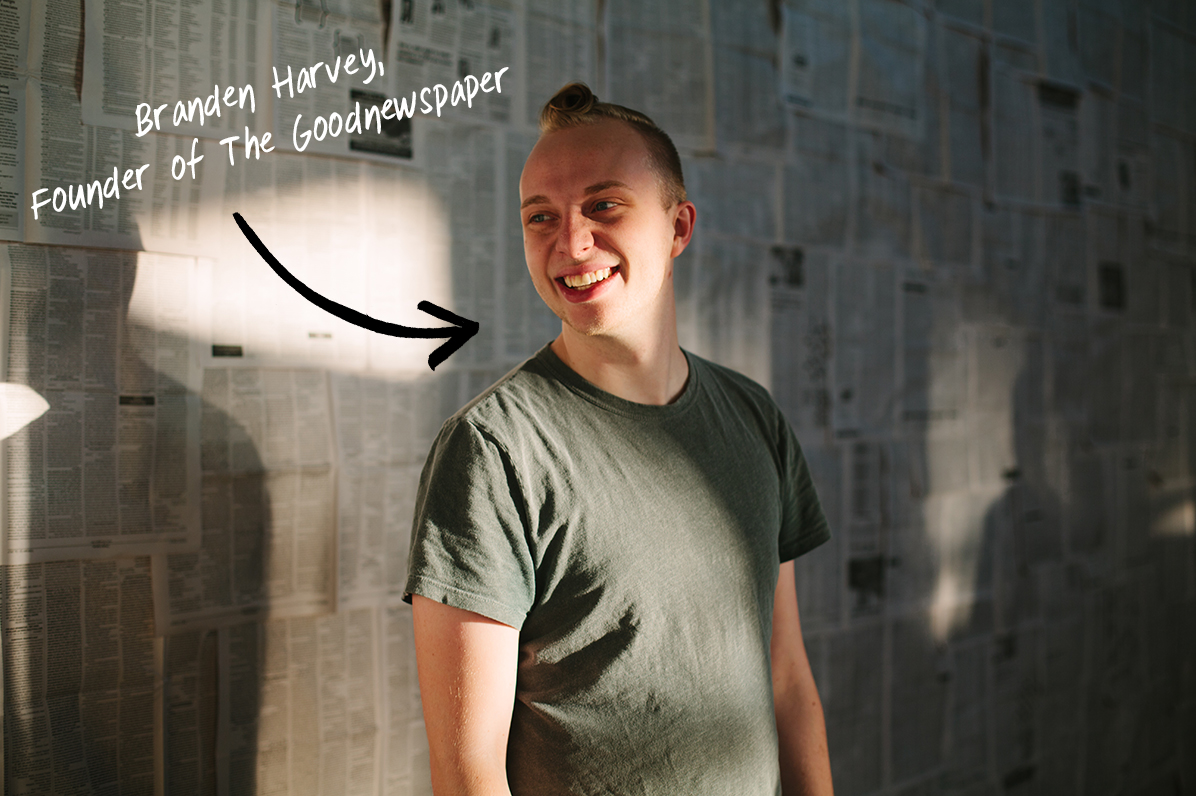
After discovering Newspaper Club, he printed some prototypes on our digital tabloids and launched a Kickstarter campaign that ended up raising over $55,000 – twice his goal! – from almost 1,500 backers.
Today, more than 2,500 people subscribe to the print edition of the Goodnewspaper and Branden’s media company Good Good Good has over 360,000 followers on Instagram. The project has been highlighted by the New York Times, Mashable, the Washington Post and more. As of this year, the Goodnewspaper is partnering with libraries worldwide to provide free digital access to all of their issues via the apps Libby and Overdrive (just search for Goodnewspaper!)
Below, Branden shares what he’s learned over the past 5 years of running the Goodnewspaper. If you’re thinking of starting your own newspaper, this guide offers a blueprint for every step of the process including:
• Funding a newspaper. How to calculate your costs and run a successful fundraising campaign.
• Launching a newspaper. How to write and design your first issue and set up a (sustainable) system for production and distribution.
• Running a newspaper. How to grow your audience, plan your content and create a steady revenue stream.
(For the tl;dr version, jump to Branden’s top 5 lessons from running the Goodnewspaper)
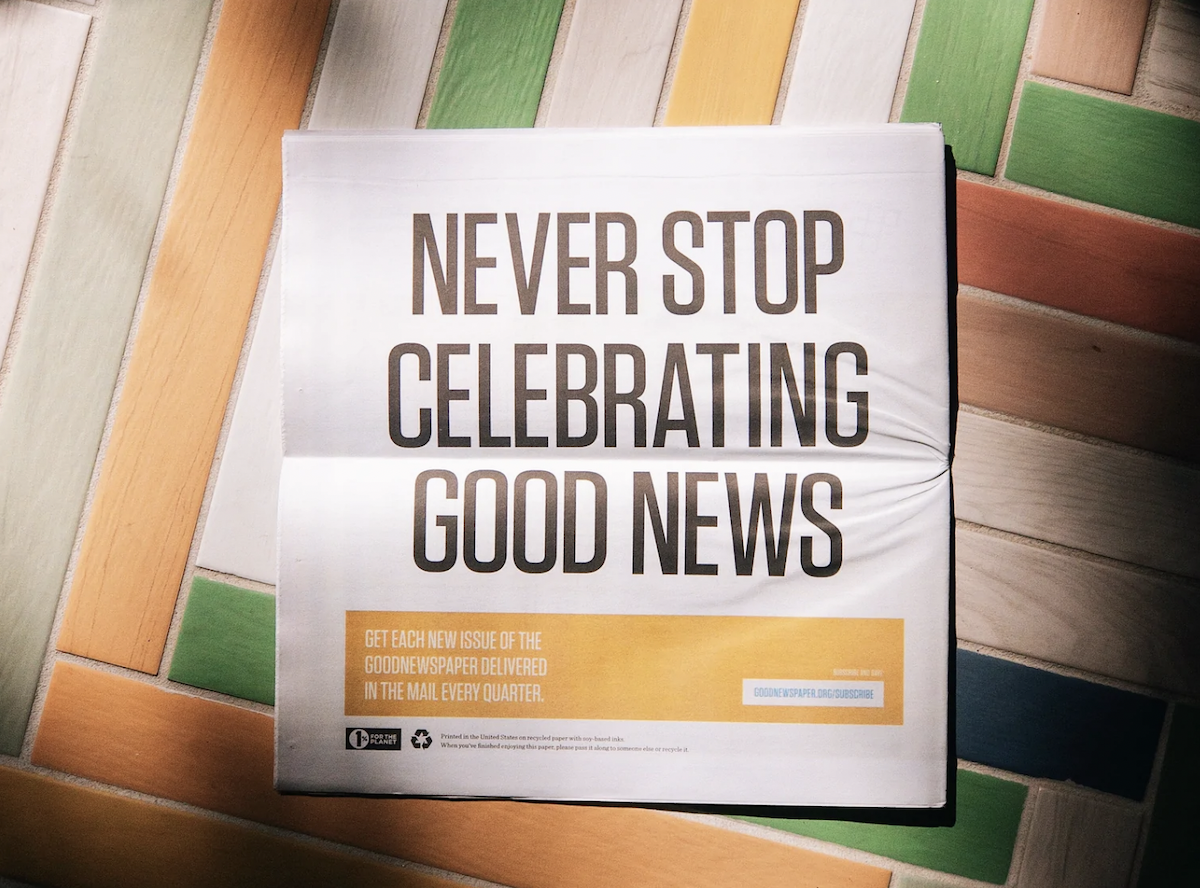
The idea
I’d spent years as a humanitarian photographer helping nonprofits and purpose-driven businesses tell their stories. I got to travel all over and meet incredible people who were solving the world’s greatest problems. It felt like such a privilege to hear these stories — and I realized that more people needed to hear them.
I was sharing some of these stories on social media, but they never performed as well as my other content. I learned from an interview I did with a happiness researcher that it’s not that people don’t care — it’s that our brains all have an internal negativity bias that actually makes us ignore good news, and instead, focus on bad news.
"I Googled 'how to print a newspaper' and Newspaper Club came up. Immediately, it felt like making a newspaper filled with good news might be possible."
And so I set out to help disrupt the way our brains are wired by doing something weird…creating a print newspaper in a digital age. The goal was simple: If our brains naturally ignore good news, then you have to wrap it in something that’s hard to ignore.
I Googled 'how to print a newspaper' and somehow Newspaper Club came up. I’d never heard of it, but I loved the aesthetic, the ethos, and the attention to detail. All things I care about.
I knew nothing about making a newspaper, so I read every blog post on the site. I ordered a free sample pack to get a vibe for what size and type of paper we might want. And even talked with their customer service team about some of my big questions.
Immediately, it felt like making a newspaper filled with good news might actually be possible.
Funding a newspaper
Even though I now knew that the newspaper part of the project would work — I still had no clue if people actually wanted a print newspaper filled with good news.
Would people pay for it? Could we actually cover our costs?
I knew one thing for sure: I couldn’t afford to pay for the whole thing if it turned out that nobody wanted to pay for it.
So we decided to use Kickstarter. Their model allows you to set a target fundraising goal — and if you don’t succeed, all the money goes back to contributors. We knew that if we didn’t hit that goal, we couldn’t make the newspaper anyway.
"The goal was simple: If our brains naturally ignore good news, then you have to wrap it in something that’s hard to ignore."
We set our goal at $26,500. Our back-of-the-napkin math found that $22,000 would be enough to cover the cost of printing, shipping, and a modest paycheck for writers and designers for four issues of the paper over the course of one year. We heard that something always goes wrong in a Kickstarter, so we added a few thousand dollars to the goal.
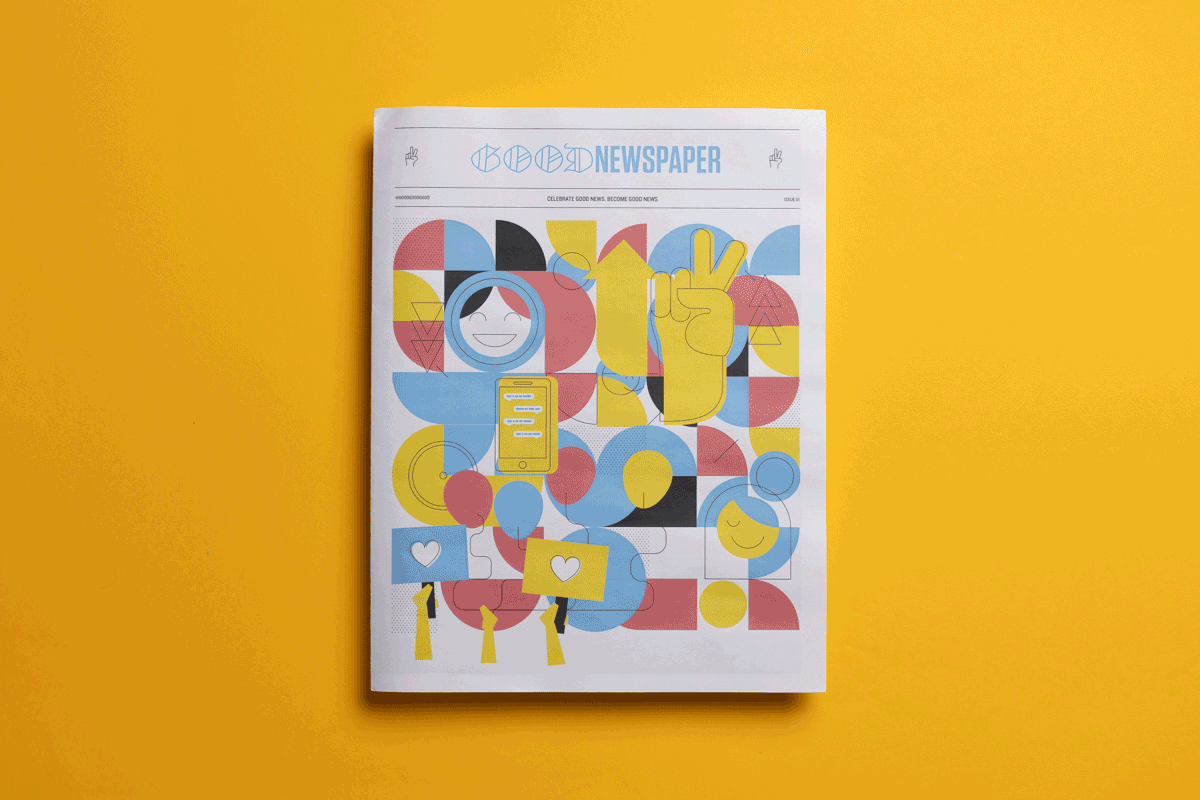
We launched that Kickstarter campaign and we were blown out of the water when we were fully funded within 56 hours — and had doubled our initial fundraising goal by the end of the 30-day campaign.
These are the 5 most important lessons we learned from our Kickstarter success:
• Create a marketing plan that counts on you bringing in 66% of the “backers” yourself. A lot of people think that getting featured by Kickstarter or getting a shoutout in news articles will make their campaign go viral. We had both of those things happen — but our analytics show those still only amounted to 1/3rd of our total revenue. For us, we reached people through my email list, my social media, and through friends in the non-profit community who I asked to share the campaign.
• Invest in a good quality video — or at the very least, great quality photos and design. Presentation really matters and most people skim words. So you have to SHOW instead of tell.
• If you can have an actual mockup of your product to show people, that’ll go a long way towards helping them believe that creating this thing is possible. Fortunately for us, we were able to print a few copies of a dummy newspaper (shown above) with Newspaper Club, and include lots of photos and videos of it in our campaign and marketing materials. We even shared copies with press.
• You’ll receive the most support in your first week and the last week. The middle weeks will be absolutely dead. Resist the urge to panic during those middle weeks (and consider planning some fun ways to drive attention during that lull).
• Make sure your rewards are focused on the actual thing you want to create. We didn’t want to create a t-shirt business, so we didn’t offer a t-shirt or other random merch as a reward. We made sure every reward included newspapers.
Launching a newspaper
After we’d met our fundraising goal, we knew the Goodnewspaper was going to happen. Now we just had to figure out how.
Writing and design
I worked in a coworking space in Nashville, Tennessee at the time, surrounded by creative people. I asked two friends, a world-class designer and a brilliant journalist, to come on board to bring the first few issues to life. They’d handle the nitty-gritty creative — and I’d handle the logistics, marketing, and vision.
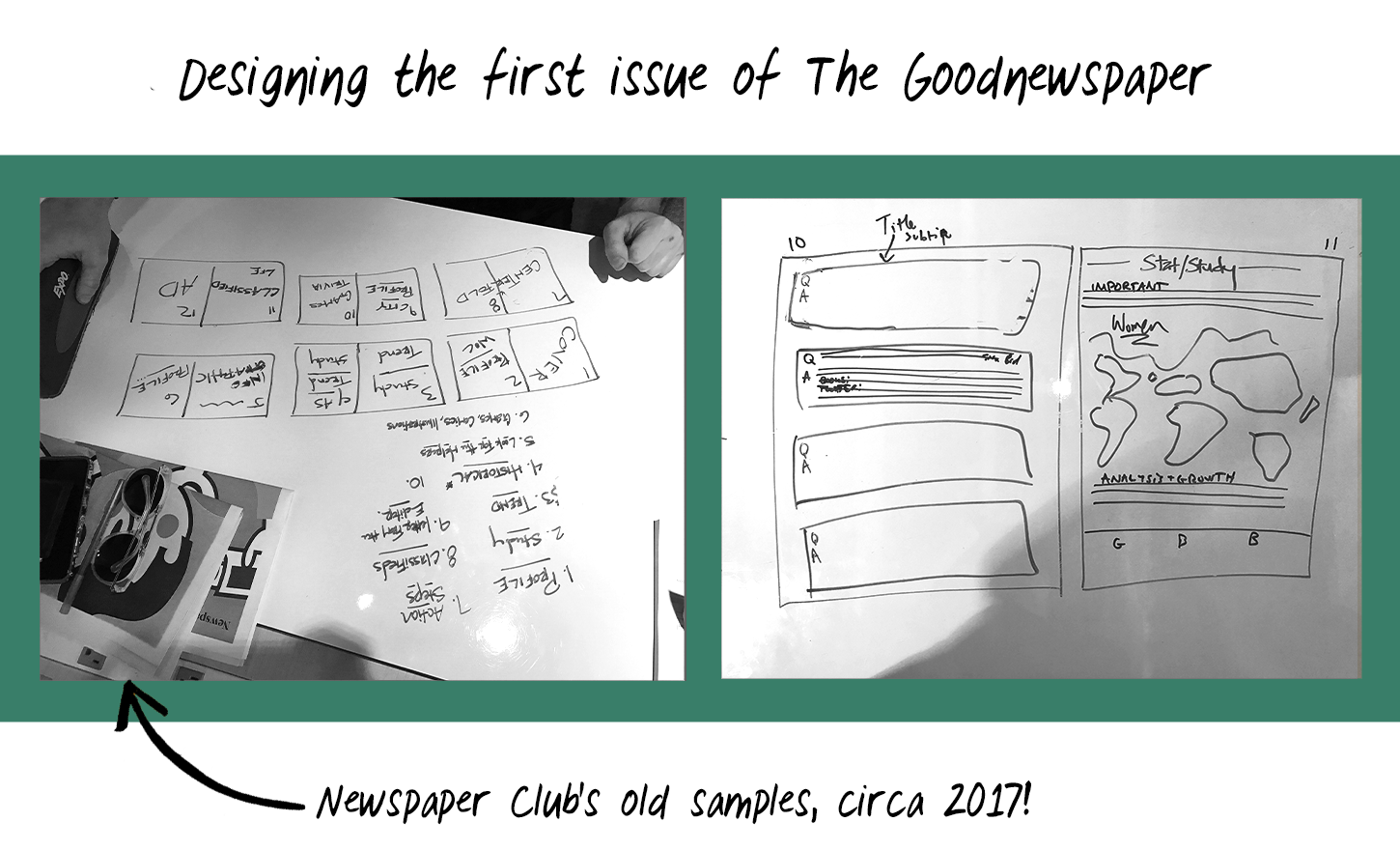
We had a series of meetings as a team where we figured out a good format for the newspaper. We wanted the beginning of each issue to be filled with as many good news stories as possible — so we created a layout design that allowed for several short stories on every page.
We knew we wanted the Goodnewspaper to be a constant reminder of the good in the world — so we turned the centerfold into a poster that people would want to hang on their walls:
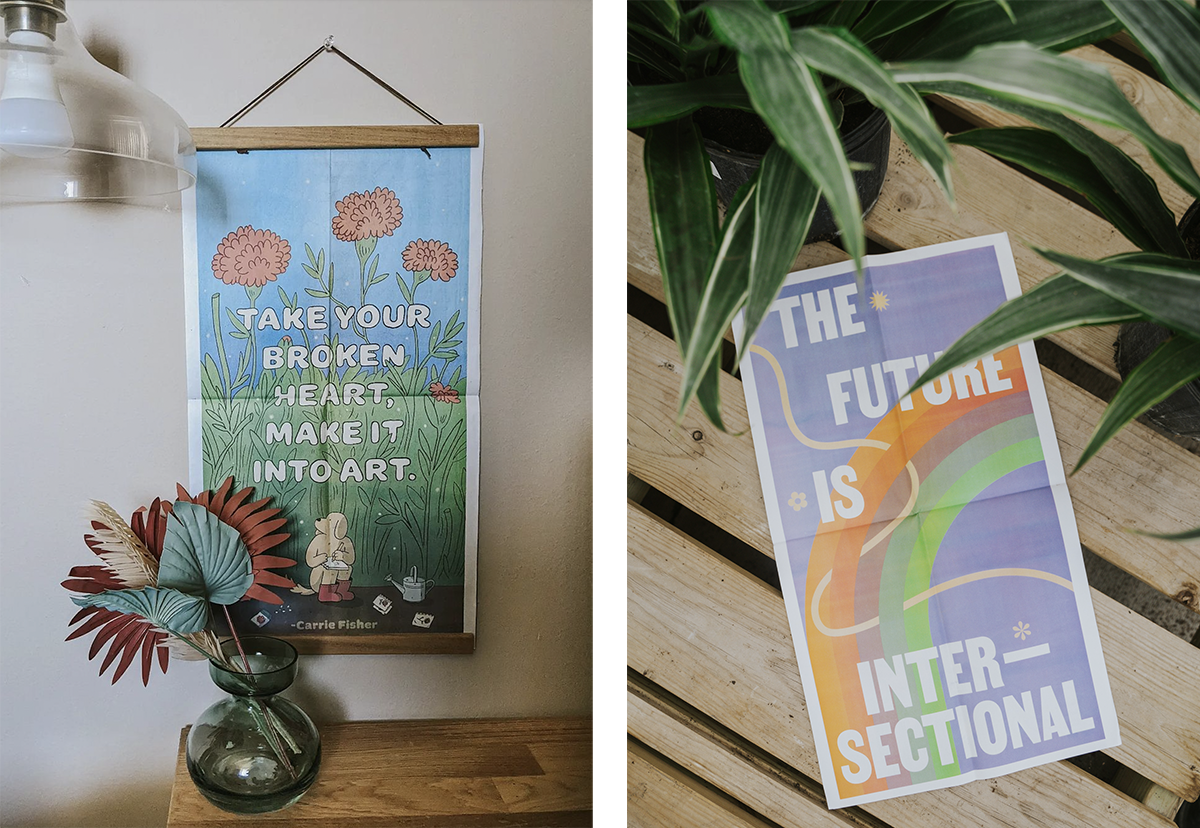
We designed the second half of the paper to allow for longer-form journalism and feature stories, with layouts that were bigger and a bit more magazine-like.
All throughout, we created space for bold, colorful, fun graphic design. This wasn’t your grandpa’s newspaper.
Printing and production
We’d had such a great first experience with Newspaper Club on the mockups that we reached out to them about working together on the actual paper.
In the kindest way possible, they told me that our Kickstarter campaign had been a little too successful. Because we’d gotten so many subscribers (and most of them were in the U.S.) it probably wouldn’t be financially viable to print thousands of copies in the UK, then ship them to my coworking space in the U.S., only for me to ship them out to our subscribers.
They helped point me in the right direction to find a different newspaper printer. I started Googling ‘cold web press Tennessee’ (and neighboring states) looking for printers who printed on newsprint.
The downside of finding a local printer instead of working with a company like Newspaper Club is: They require much higher minimums, most don’t have digital printing, and working with them for artistic endeavors can require more hands-on creative control.
"While we aim for excellence, newsprint lends itself really well to imperfections. Every copy is a bit different from the next."
I started calling companies one by one (many of them aren’t super tech-savvy, so we found that phone calls worked best). I was looking for printers that could handle roughly 5,000 to 10,000 newspapers in a print run (rather than the 50,000 to 100,000 many were used to) and could work with us on creating a product that felt very artistic (most of their existing clients weren’t as focused on design and perfection as we are). Lastly, we also wanted to work with a printer that cared about sustainability.
We ended up finding a fantastic printer not too far away. They were willing to work with us on nerdy design details, plus I could be on-site on printing days to give feedback (and document the excitement of printing).
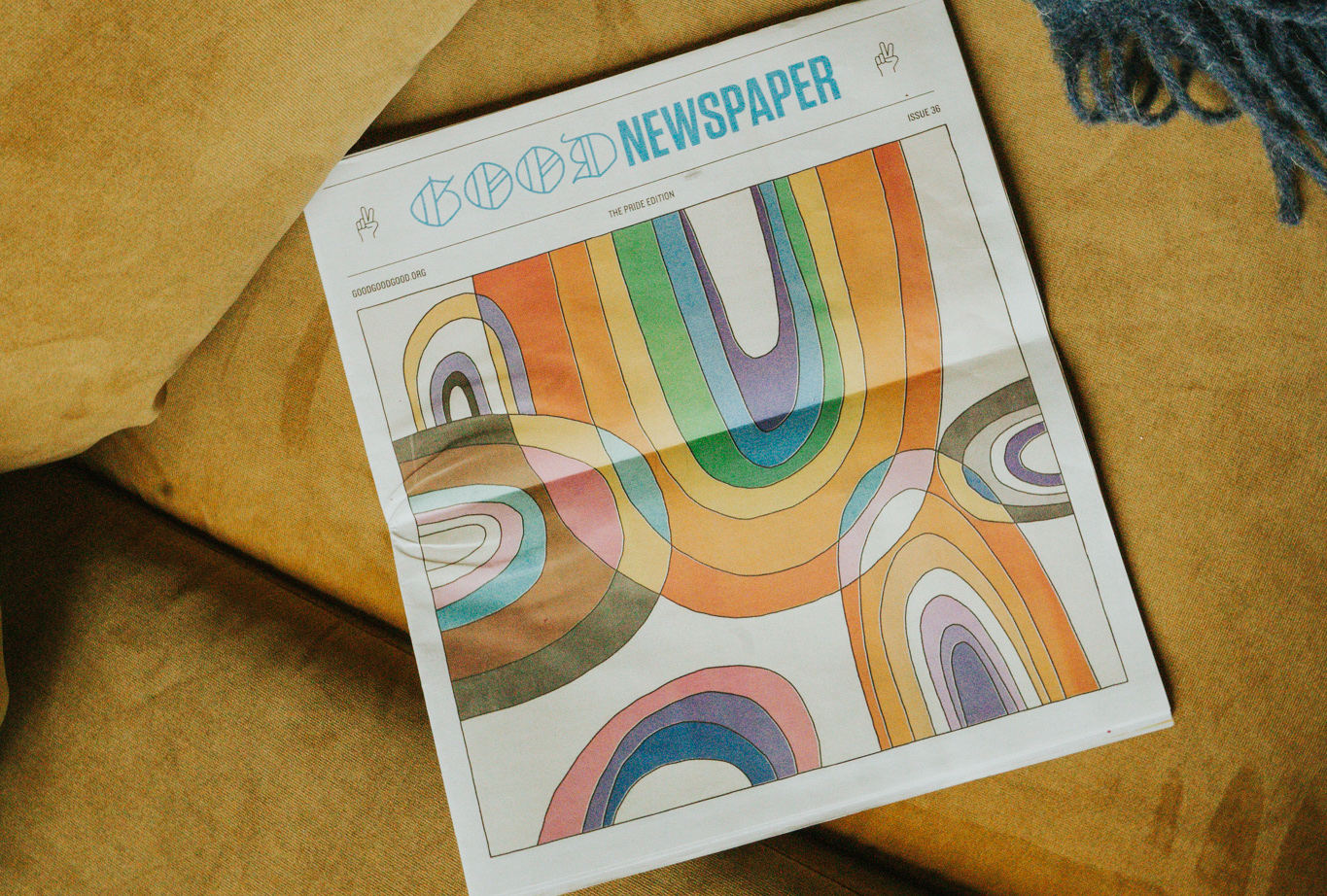
Distribution
Distribution is where we really messed up. We had no idea what we were doing with shipping and fulfillment, so we reached out to a local warehouse that did fulfillment for merch for musicians in Nashville. They had a ton of experience, and they helped walk us through the process.
They were generous enough to share their knowledge, but we quickly found out that outsourcing shipping didn’t work at our price point. Rather than shipping $30 band t-shirts in a big package — we needed to ship small $10 newspapers in an envelope. The fulfillment warehouse’s cost-per-newspaper was way too expensive for us.
"A newspaper is an incredible way to make a splash. Whatever story you’re trying to tell, you can stand out by putting it in a unique medium."
After our first few issues, we pivoted to doing all the shipping ourselves. We literally loaded boxes from the printer into my Toyota Corolla, then unloaded them at my coworking space. One by one, we packed them into recycled envelopes in the conference room — and then hand-stamped the envelopes with the Goodnewspaper logo and stuck on a shipping label.
Finally, a few years later, we figured out the ultimate plan: We ended up printing our newspapers “inside out” so the back cover would be on the outside. We could use the back cover as a kind of “envelope” (shown below) — and print the shipping label directly on the back of the newspaper. (If you do this, make sure you run the size of your newspaper by the postal service. Pricing depends on the size of your newspaper.)

This allowed us to reduce waste by getting rid of envelopes, still protect the front cover to ensure it showed up in great quality, and significantly reduce the manual work we had to do with each issue. Even better, our printer was now able to actually do the shipping for us — because they had their own label printing device and experience doing similar fulfillment.
At long last, a sustainable process for us (that didn’t require me to lug boxes to and from my car).
Running a newspaper
When it comes to running a monthly newspaper, I’ve learned a lot through the years (mostly from making mistakes).
Growing your audience
When you’re trying to grow your audience, it helps to focus on something very specific that solves a problem for someone. For us, we just focus on good news — and we do that in the context of helping people process that bad news of the world in a way that leaves them feeling more hopeful (and better equipped to make a difference for others). Hone in on your specific purpose and just keep leaning into that.
Planning your content
We’re much more organized now than we used to be, and as a result, I think the newspaper is better than ever. We have the themes for the next 10 issues of the Goodnewspaper planned out, and we start each issue roughly 90 days before publication day. For some issues, we start even earlier if we know we’ll have some more complex pages. And we’re going to try to get an extra month ahead by the end of the year so we can all have a chill holiday season.
"The number one reason people talk about us online and offline is because of the newspaper. It’s unique, it’s weird, and it’s fun."
We track each page’s progress (from concepting, to writing, then editing, and designing) in Notion — and keep all of our documents together in a shared Google Doc. We keep our InDesign file in a shared Dropbox folder, and we take turns “checking it out” so we never overwrite each others’ work.
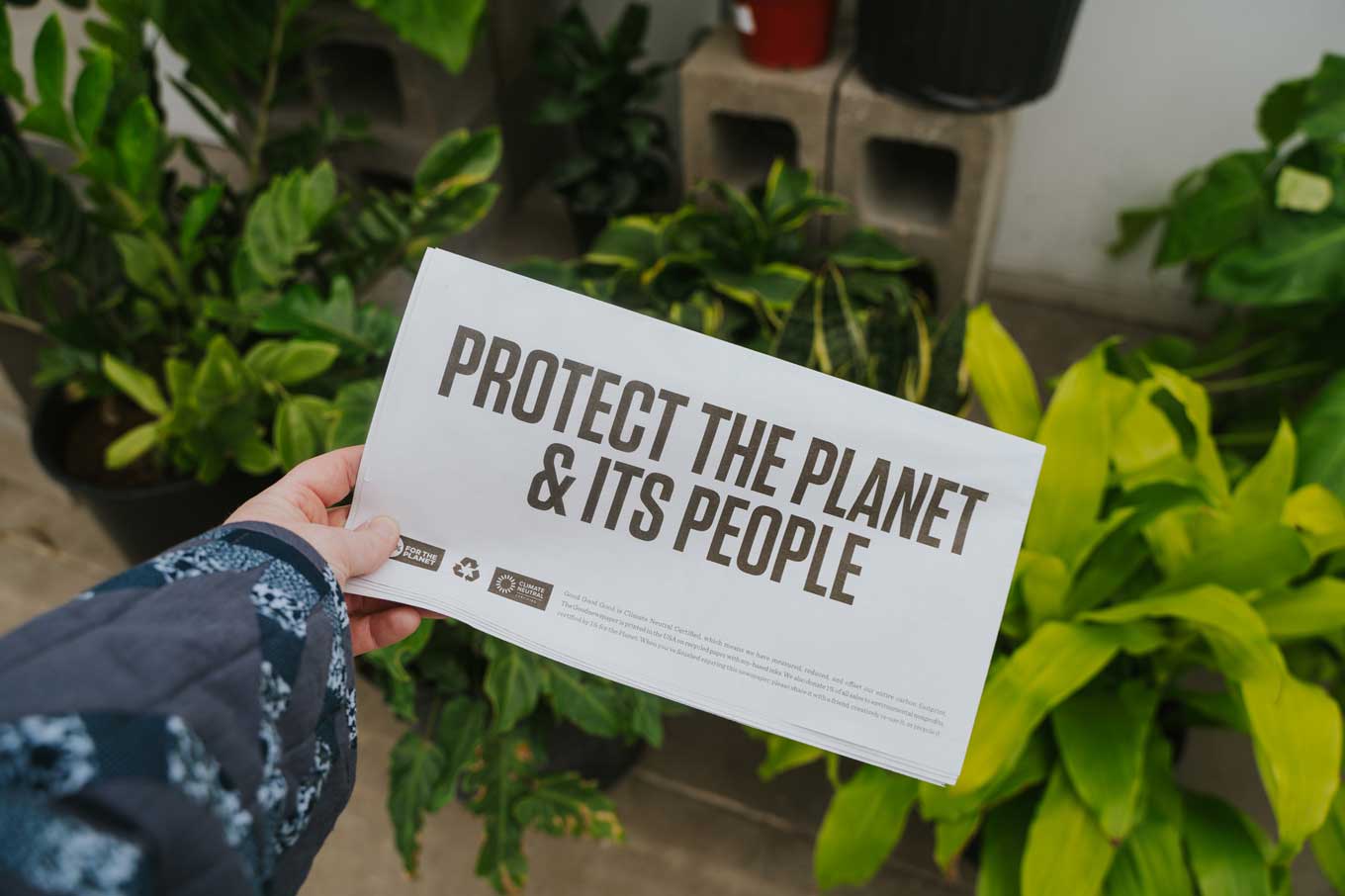
Building your team
We’ll likely never have a team as large as a traditional magazine or newspaper — and that’s okay. We’re really proud of what we’re able to accomplish as a small, scrappy team. Each Goodnewspaper is currently created by two writers/editors, one art director/designer, and me.
But our media company Good Good Good does more than just the Goodnewspaper — and so we have other team members focused on social media, email marketing, and customer service. (My first hire after building out the Goodnewspaper team was for someone to help with customer service. Anytime you’re accepting people’s money and managing shipping delays, lost packages, etc, it’s incredibly important to have someone who can be responsive and helpful when things go wrong or when a customer is confused.)
Keeping your revenue consistent
The Goodnewspaper is primarily funded by monthly subscribers, rather than advertising. While we do have ads from like-minded brands (making a positive difference in the world) from time to time, we don’t rely on advertising to get by.
This allows us to make our number one focus serving our readers. We create newspapers that bring value to their lives and center on issues they care about.
It’s also very consistent revenue, which helps us plan ahead to invest in our team and hire diverse and talented contributors for each issue!
Branden's top 5 lessons from running the Goodnewspaper
1. A newspaper is an incredible way to make a splash. Even though there are more people who visit our website every day than subscribe to the Goodnewspaper each month, the number one reason people talk about us online and offline is because of the newspaper. It’s unique, it’s weird, and it’s fun. Whatever story you’re trying to tell, you can stand out by putting it in a unique medium.
2. The most fulfilling part of any creative project is inviting others to join you. Even if I could make the Goodnewspaper on my own, I wouldn’t want to. My incredible team brings joy, wisdom, and creativity to this endeavor that I could never have imagined. And we just have fun bringing this to life together. Find good people and bring them along with you.
3. Embrace imperfections. Whether you accidentally included a typo, your ink bled onto the next page, or you printed an RGB illustration instead of a CMYK illustration, at some point, something is going to go wrong with your final design. While we should aim for excellence, I’ll admit that the medium of newsprint lends itself really well to imperfections. Every copy is a bit different from the next. Instead of getting frustrated over the mistakes made along the way, celebrate the uniqueness of your creation.
4. Build empathy into every stage of the creation process. Ask yourself how a design decision will affect readers, think through what the most helpful angle for an article will be, and continually ask yourself how you can bring the most value to the people who will receive this newspaper. When in doubt, talk to people (especially people who are different from you) and ask what would be the most helpful. It’s the only way to keep creating year after year.
5. You don’t have to (and can’t) know everything when you start your project. When I launched the Goodnewspaper, I didn’t know the first thing about print production, shipping, or even running this kind of business. I just had expertise on our topic from my work with nonprofits — and knew that others might want this. With a mindset of curiosity and determination, I figured everything else out as I went along. And you will, too.
Most photos featured in this post were taken by Kamrin Baker, managing editor of the Goodnewspaper.
Make your own newspaper with Newspaper Club. Print runs start at 1 copy!
If you’re looking to create a newspaper using Canva, you’re in the right place. At Newspaper Club, we make it simple to design and print...
Weddings are full of stories – how you got engaged, why you chose your venue or the flowers in your bouquet and all the little decisions...
So much thought goes into every part of your wedding, from the venue to the playlist to the colour of the napkins. But there’s only so...